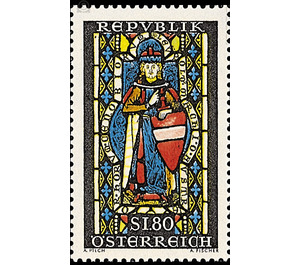monasteries - Austria / II. Republic of Austria 1967 - 1.80 Shilling
Theme: Art & Culture
| Country | Austria / II. Republic of Austria |
| Issue Date | 1967 |
| Face Value | 1.80 |
| Color | multi-colored |
| Printing Type | combination printing |
| Stamp Type | Commemorative |
| Item Type | Stamp |
| Chronological Issue Number | 595 |
| Chronological Chapter | OOS-OE2 |
| SID | 262119 |
| In 63 Wishlists | |
Margrave Leopold III. is not only the patron of Austria, but must also be counted among the great historical figures of the country. Under his government, the Principality of Austria developed in Austria, laying the foundations for the self-development and later greatness of the country. It is believed that he was born around the year 1075. After the death of his father, he began to rule, about 20 years old. He kept away from the great politics and dedicated all forces Austria. He never led a war of aggression and did not participate in the popular crusades. He regarded the care of his country as the most important duty to God and stayed at home. In this long peacetime Austria flourished economically and culturally. He married the daughter of Emperor Heinrich, which brought him not only a rich dowry, but also secured him as a stepfather of the Staufer a place in history. The pious Margrave died on 15 November 1136. His veneration as a saint arose spontaneously among the people. The Habsburgs did not begin their canonization in Rome until the beginning of the 14th century, which was completed in 1485 by Pope Innocent VIII. In 1663, Emperor Leopold I proclaimed the saint's namesake official patron. The stamp depicts the oldest surviving image of the Margrave, a glass painting from the windows of the Brunnenhaus in Heiligenkreuz Abbey.


